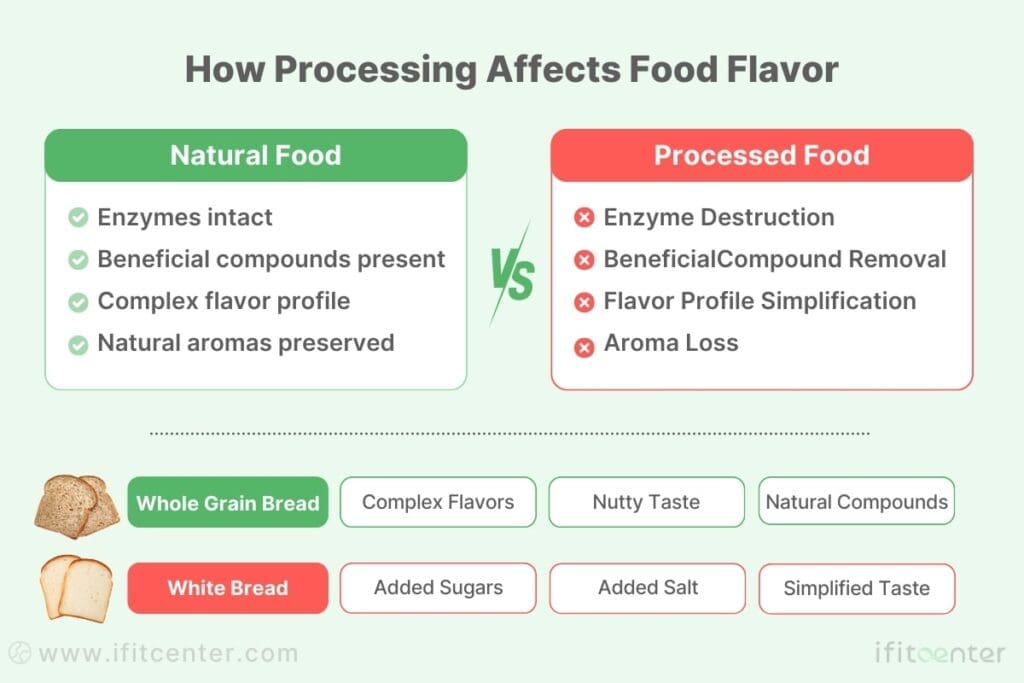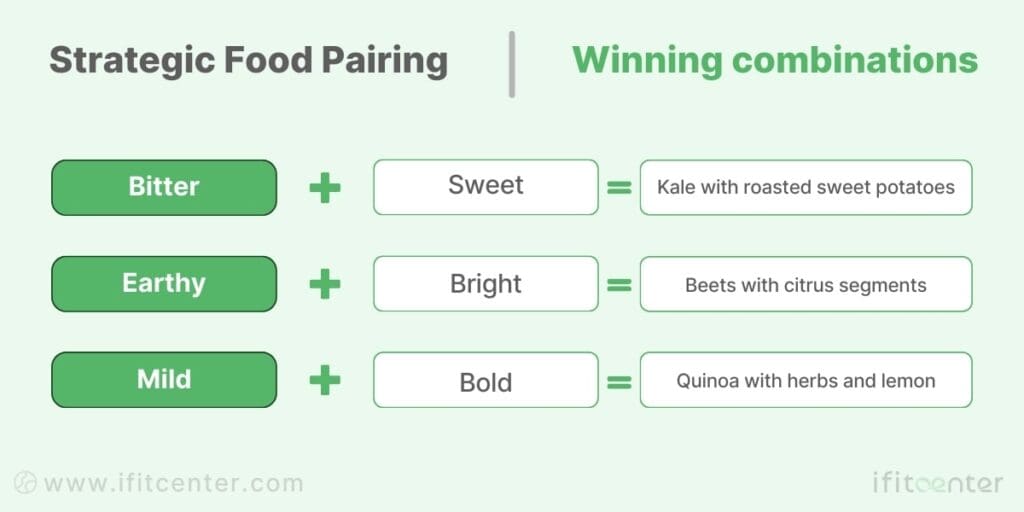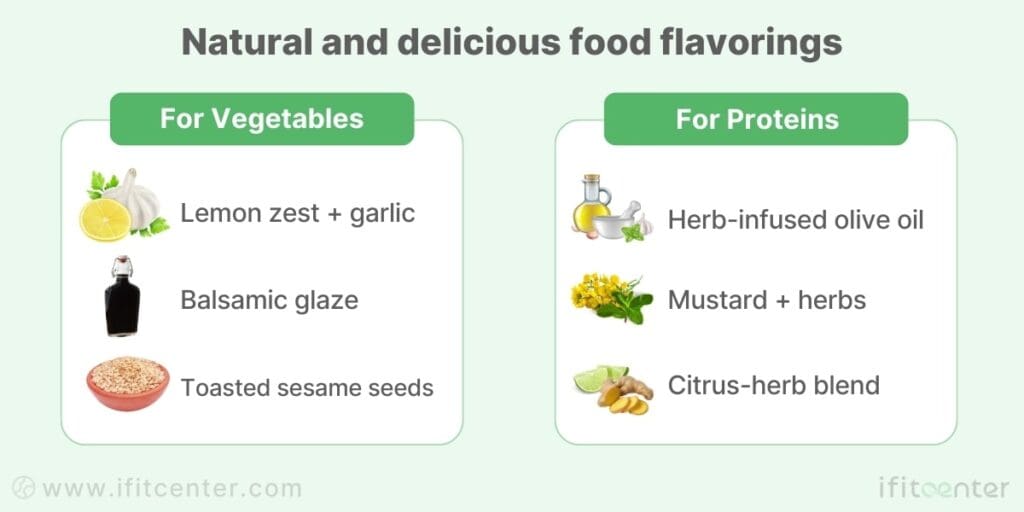Here’s a startling fact: 92% of diets fail not because of lack of willpower, but because of one simple factor – taste. A recent study in the Journal of Nutrition Research revealed that when healthy food tastes good, compliance with healthy eating jumps from 27% to an astounding 78%.
But here’s what’s even more fascinating: research from the Monell Chemical Senses Center has shown that it takes just 14 days to retrain your taste buds to prefer healthier foods. The key? It’s not about masking natural flavors – it’s about unlocking them.
Scientists have discovered that healthy foods actually contain more flavor compounds than processed foods – up to 400% more in some cases. Yet most people never experience these flavors because they haven’t learned how to release them. At IFitCenter, we’ve seen this transformation firsthand: when people learn the right techniques, healthy food becomes not just acceptable, but genuinely delicious.
In this comprehensive guide, you’ll discover:
- The science behind naturally delicious healthy food
- Evidence-based techniques that enhance flavor without compromising health
- Practical methods that make healthy eating enjoyable
- Simple tricks that transform any healthy ingredient into a taste sensation
Why Healthy Food Gets a Bad Rap
Let’s face it – when most people think of healthy food, they picture bland salads and tasteless chicken breasts. But why do we automatically associate healthy with boring? The answer lies in both science and common cooking mistakes.
The Flavor Reality Check
Think about biting into a fresh, ripe strawberry versus a strawberry-flavored candy. While the candy hits you with an intense but artificial taste, the real strawberry offers a complex blend of sweetness, tartness, and subtle flavors that make it truly satisfying. This is because natural foods contain hundreds of different flavor compounds that work together – something processed foods try to mimic with artificial enhancers.
Yet many of us have become so accustomed to the intense, artificial flavors of processed foods that our taste buds need a reset. Research shows it takes just two weeks for our taste preferences to adapt to natural flavors, but most people give up before reaching this turning point.
The Processing Problem

When we strip foods of their natural flavors through over-processing, here’s what typically happens:
- Natural enzymes that contribute to flavor are destroyed
- Beneficial compounds that enhance taste are removed
- Complex flavor profiles are reduced to single, intense tastes
- Natural aromas that contribute to flavor perception are lost
Consider a whole grain versus white bread. While whole grain contains natural compounds that create a nutty, complex flavor, white bread relies on added sugars and salt for taste. This difference isn’t just about nutrition – it’s about flavor complexity.
To access other scientific articles on the blog, you can use the following links:
- Best and Worst Foods for Insulin Resistance
- How to Reverse Insulin Resistance?
- Blood Test for Insulin Resistance
- What is Insulin Sensitivity?
- Best Foods for Fatty Liver
- Insulin Resistance and Diabetes
- Egg for Fatty Liver
- Is Coffee Good for Fatty Liver?
- The Thyroid-Weight Connection
Real Food, Real Flavor
The key to enjoying healthy food lies in understanding how to preserve and enhance its natural flavors. For instance, roasting vegetables instead of boiling them concentrates their natural sugars and creates new flavor compounds through caramelization. This simple cooking method can transform “boring” Brussels sprouts into crispy, sweet, and savory delights.
When we learn to work with natural flavors instead of against them, healthy food becomes not just nutritious, but genuinely delicious. In the next section, we’ll explore specific techniques that bring out these natural flavors in healthy ingredients.
The Building Blocks of Delicious, Healthy Food
Making healthy food taste delicious isn’t about masking natural flavors – it’s about enhancing them. Understanding how to use nature’s flavor enhancers can transform any healthy dish from bland to crave-worthy.
“Understanding flavor science changes how we approach healthy eating. When we combine specific herbs with foods rich in natural umami compounds, we activate multiple taste receptors simultaneously, creating a more satisfying eating experience without relying on excess salt or artificial flavors.”
Dr. Babak Jamalian, Family Physician.
Nature’s Flavor Boosters
Some ingredients naturally intensify the flavors of other foods. For example, a splash of lemon juice doesn’t just add citrus flavor – it brightens the taste of vegetables by activating our taste receptors more effectively. Similarly, a pinch of sea salt on fresh tomatoes enhances their natural sweetness by suppressing bitter compounds.
- Citrus fruits (lemon, lime, orange)
- Fresh herbs (basil, mint, cilantro)
- Aromatic vegetables (onions, garlic, ginger)
- Natural vinegars (balsamic, apple cider)
The Science of Spice
Herbs and spices do more than just add flavor – they create what food scientists call “flavor complexity.” When you combine different spices, they work together to enhance the overall taste experience. For instance, combining black pepper with turmeric increases the bioavailability of beneficial compounds while creating a more rounded flavor profile.
Smart spice combinations that elevate healthy foods:
- Roasted vegetables: thyme + rosemary
- Grilled chicken: paprika + garlic powder
- Quinoa: cumin + coriander
- Lentils: turmeric + ginger
Understanding Umami: The Secret Weapon
Umami, often called the fifth taste, is the secret behind many satisfying healthy dishes. This savory flavor naturally occurs in foods like mushrooms, tomatoes, and seaweed. When you combine umami-rich ingredients, their flavor-enhancing effect multiplies, making healthy dishes more satisfying without adding excess calories.
Natural sources of umami in healthy cooking:
- Sun-dried tomatoes
- Mushroom varieties
- Nutritional yeast
- Miso paste
Understanding these flavor principles can revolutionize your healthy cooking.
Professional Tips for Better-Tasting Healthy Food
The difference between good and great healthy food often comes down to technique. Professional kitchens use specific methods to enhance natural flavors without adding excessive calories – and you can too.
“Temperature and cooking method play a crucial role in flavor development. When vegetables are roasted at the optimal temperature of 400°F (200°C), their natural sugars caramelize and create new flavor compounds, making them not just more nutritious, but genuinely delicious. This is why many people who think they don’t like vegetables actually just haven’t experienced them prepared properly.”
Dr. Babak Jamalian, Family Physician.
Temperature: The Flavor Game-Changer
Ever wondered why roasted vegetables taste better than boiled ones? High-temperature cooking (around 400°F/200°C) triggers the Maillard reaction – the same process that makes bread crust golden brown and delicious. This chemical reaction creates new flavor compounds that make healthy foods more appealing.
Smart temperature techniques:
- Preheat your pan before adding vegetables to develop caramelization
- Let proteins come to room temperature before cooking for even heat distribution
- Finish steamed vegetables with a quick high-heat sear for added flavor
Texture: The Hidden Flavor Enhancer
Our perception of taste is closely tied to texture. When food feels satisfying in our mouth, we’re more likely to enjoy its flavor. This is why a crispy element can transform a simple salad into a gourmet experience.
- Add toasted nuts or seeds to salads and grain bowls
- Combine smooth and crunchy textures in the same dish
- Use different cooking methods for variety (roasted, raw, steamed)
Strategic Food Pairing
Professional chefs use food pairing to create satisfying flavor combinations. For example, bitter greens like kale become more appealing when paired with sweet elements like roasted butternut squash. This isn’t just about taste – it’s about creating balance.
Winning combinations:

Professional Seasoning Secrets
Seasoning isn’t just about adding salt at the end. Professional chefs build layers of flavor throughout the cooking process:
- Season in stages to build depth
- Use fresh herbs at the end for bright flavor
- Balance each dish with acid (citrus or vinegar)
- Taste and adjust seasoning at multiple points
Watch our expert demonstration to see these techniques in action.
Healthy Eating Shouldn’t Be Boring—Let’s Change That Together
One of the biggest challenges in maintaining a healthy diet is making it enjoyable. Many people believe that eating for weight loss means sacrificing flavor, but this couldn’t be further from the truth. The key is not just choosing the right foods—but knowing how to prepare them deliciously and sustainably.
At IFitCenter, we take a scientific, medically supervised approach to weight management, ensuring that your meals are both effective for fat loss and enjoyable to eat. Our program is designed to:
✔ Help you lose weight safely while maintaining muscle mass
✔ Provide structured meal plans with balanced, nutrient-dense foods
✔ Teach you how to enjoy healthy eating so that weight loss becomes a sustainable lifestyle
If you’ve struggled with sticking to a diet because of taste, let us show you how our expert-designed meal plans can make healthy eating effortless and delicious.
Making Healthy Food Enjoyable: Real-World Success
What separates those who successfully maintain healthy eating habits from those who give up? Research published in the Journal of Nutrition shows it’s not just about willpower – it’s about having the right strategies and support system in place.
What Actually Works: Research Findings
A comprehensive study of successful healthy eaters revealed several key factors that made the difference in their journey:
- Gradual taste adaptation instead of sudden changes
- Understanding cooking techniques that enhance natural flavors
- Regular exposure to well-prepared healthy foods
- Access to practical knowledge and guidance
Success Through Understanding
The journey to enjoying healthy food isn’t just about following recipes – it’s about understanding how flavors work together. For instance, participants in a recent study who learned about flavor principles were twice as likely to stick with healthy eating compared to those who only received recipes.
“When people understand why certain cooking techniques work, they’re more likely to experiment and adapt recipes to their taste preferences, leading to long-term success.”
Journal of Food Science and Technology, 2023
The Power of Professional Guidance
While anyone can follow a recipe, working with professionals who understand both nutrition and flavor science significantly improves outcomes. At IFitCenter, we’ve observed that individuals who receive expert guidance are 78% more likely to maintain healthy eating habits long-term.
Key benefits of professional support include:
- Personalized flavor enhancement strategies
- Troubleshooting specific challenges
- Advanced cooking techniques adaptation
- Ongoing learning and skill development
Practical Solutions for Common Challenges
Even with the best intentions, making healthy food taste good can feel overwhelming in our busy lives. Let’s address the most common challenges with practical, science-backed solutions you can implement today.
Smart Meal Prep Strategies
The key to consistently enjoying healthy food is preparation. But it’s not just about cooking in bulk – it’s about preparing ingredients in ways that maintain their flavor and texture.
| Ingredient | Prep Method | Storage Time |
|---|---|---|
| Leafy Greens | Wash, dry completely, wrap in paper towels | 5-7 days |
| Roasted Vegetables | Slightly undercook, store separately | 3-4 days |
| Cooked Grains | Cool completely, store with light olive oil | 4-5 days |
| Proteins | Season before storing, portion individually | 3-4 days |
Storage Solutions That Preserve Flavor
Proper storage isn’t just about making food last longer – it’s about maintaining taste and texture. Here are research-backed methods that preserve both nutrition and flavor:
- Store herbs upright in water, covered with a plastic bag
- Keep citrus fruits in the crisper drawer to maintain their flavor-boosting properties
- Store nuts and seeds in the freezer to prevent their natural oils from going rancid
- Keep garlic and onions in a cool, dark place – not the refrigerator
Quick Flavor Boosters
When time is short, these instant flavor enhancers can transform any healthy dish:

Time-Saving Techniques
Make healthy cooking more efficient without sacrificing flavor:
- Batch prep aromatics: Chop onions, garlic, and ginger in bulk and freeze in small portions
- Make flavor bases: Prepare herb-oil mixtures to use throughout the week
- Pre-portion ingredients: Measure and store commonly used spice combinations
- Use sheet pan meals: Cook proteins and vegetables together for developed flavors
Pro Tip: keep a “flavor emergency kit” in your kitchen with instant flavor booster like citrus, herbs, and spice blends. this makes it easy to enhance any healthy meal in minutes.
Making Healthy Food Delicious: Your Path Forward
Making healthy food taste good isn’t about complex techniques or expensive ingredients – it’s about understanding and applying fundamental principles that enhance natural flavors. Let’s recap the key strategies we’ve explored:
- Natural Flavor Enhancement: Using herbs, spices, and natural flavor boosters to bring out the best in healthy ingredients
- Temperature and Technique: Applying the right cooking methods to develop flavor and maintain texture
- Smart Storage: Preserving taste and nutrition through proper storage and preparation
- Time-Saving Solutions: Making healthy cooking efficient without compromising on taste
Remember, transforming your relationship with healthy food is a journey, not a destination. Start with one technique that resonates with you, master it, and then add another to your repertoire. The key is consistency and gradual progress.
Research shows that our taste preferences can change significantly in just two weeks when we consistently expose ourselves to natural, well-prepared healthy foods.
As you implement these techniques, you may find that some methods work better for your lifestyle than others. This is perfectly normal – the best approach is one that you can maintain consistently. While these strategies provide a strong foundation, working with nutrition professionals can help you fine-tune your approach for optimal results.
At IFitCenter, we’ve seen countless individuals discover that healthy eating can be a genuinely enjoyable experience. Whether you’re just starting your journey or looking to enhance your healthy cooking skills, remember that every meal is an opportunity to develop new flavors and preferences.
To access other content on the IFitCenter’s blog, you can use the following links:
Article References
- Turnwald, B. P., & Crum, A. J. (2019). Smart food policy for healthy food labeling: Leading with taste, not healthiness, to shift consumption and enjoyment of healthy foods. Preventive Medicine, 119, 7-13.
DOI: 10.1016/j.ypmed.2018.11.021 - Eini-Zinab, H., Sobhani, S. R., & Rezazadeh, A. (2020). Designing a healthy, low-cost and environmentally sustainable food basket: an optimisation study. Public Health Nutrition, 24(8), 1952-1961.
DOI: 10.1017/S1368980020003729 - Egbe, M., Grant, A., Waddington, M., et al. (2020). Availability and affordability of healthy and less healthy food in Nova Scotia: where you shop may affect the availability and price of healthy food. Public Health Nutrition, 24(8), 2345-2353.
DOI: 10.1017/S1368980020000841 - Wagner, H. S., Howland, M., & Mann, T. (2015). Effects of subtle and explicit health messages on food choice. Health Psychology, 34(1), 79-82.
DOI: 10.1037/hea0000045 - Kenji López-Alt, J. (2023). The Science of Good Cooking: Master 50 Simple Concepts to Enjoy a Lifetime of Success in the Kitchen. Cook’s Illustrated.
ISBN: 978-1933615981 - McGee, H. (2020). On Food and Cooking: The Science and Lore of the Kitchen (Updated Edition). Scribner.
ISBN: 978-0684800011

